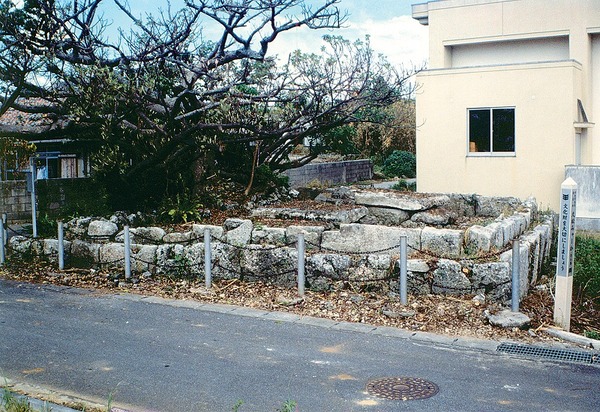トップ > 市の組織 > 教育委員会 > 生涯学習部 > 生涯学習振興課 > 【市指定:建造物】久松ミャーカ(巨石墓)群
【市指定:建造物】久松ミャーカ(巨石墓)群
〔ひさまつみゃーか(きょせきばか)ぐん〕
みゃーかは、久貝、松原両字にまたがって、かつては多数あったと推定されるが、現在確認できるのは4基である。みゃーかについて久松では古くから“ぶさぎ”とよびならわしている。稲村賢敷(いなむらけんぷ)・金子エリカ両氏の研究報告があり、創建は14~16世紀ごろと推定される。
稲村説「宮古在来の風葬墓地(ふうそうぼち)で、15世紀末ごろまで巨大なものへと発達、その後沖縄本島の影響をうけて横穴式へ移行」金子説「1360年ごろから元・明動乱をさけて、優秀な技術をもって大陸から渡来した一群の人々によってつくられた」などである。
久貝ぶさぎは、仲宗根豊見親の夫人宇津免嘉(うつめが)の父安嘉宇立親の墓と言い伝えている。仲宗根豊見親のころに宮古の石造建築物はいちじるしく発達したとみられるだけに、久松みゃーか群は、宮古の「古琉球期」時代を解明していく上で重要なカギを秘めているものと考察される。
【Designated by the City:Structure】Hisamatsu Myaka (Giant Rock Tomb) Cluster
It is estimated that there were numerous Myaka tombs in the past, spreading out over the two hamlets of Kugai and Matsubara. However, only four tombs can be observed today. The Myaka have been referred to as “Busagi” in Hisamatsu, since long ago. From the research reported by both Kenpu Inamura and Erica Kaneko, it is estimated that the tombs were constructed from the 14th to the 16th centuries.
According to the theories of Inamura, the Myaka tombs were “Fuso-bochi tombs native to Miyako that progressed to massive graves up until the end of the 15th century. Later, the local tombs became vertical openings, influenced by those from Okinawa Island.” Further, according to Kaneko’s theory, the tombs were “constructed by a group of finely skilled people that migrated here from the continent who had left their land to avoid turmoil during the transition period between Yuan and Ming dynasties around 1360.”
The Kugai Busagi is said to be the tomb of Akaudatiuya, the father of Utsumega, who was the wife of Nakasone Tuyumya. As the peoples’ skills in constructing stone structures greatly advance during the time of Nakasone Tuyumya, the Hisamatsu Myaka tomb cluster is considered to be of significant importance in understanding the history of Miyako during the ancient period of the Ryukyu Kingdom.
【市指定:建筑物】久松巨石墓群
巨石墓橫跨字久貝和字松原兩地,據說過去有許多座,現在已確認的只有4座。關於巨石墓,久松自古以來稱之為「布撒基」。根據稻村賢敷和金子Erika二人的研究報告,推斷這些墓創建於14~16世紀左右。
稻村氏認為「該墓群為宮古固有的風葬墓地,到15世紀末時發展成巨大的墳墓,後來受到沖繩本島的影響轉變為橫洞式」。金子氏認為「1360年前後,為了躲避元・明朝的動亂,一批擁有優秀技術的人從中國大陸跨海來到這裏,並建起了這些墳墓」。
據傳說,久貝布撒基是仲宗根豐見親的夫人宇津免嘉之父安嘉宇立親的墳墓。正因為在仲宗根豐見親的時代,宮古的石造建筑物得到顯著的發展,久松巨石墓群被視為在解剖宮古的「古琉球期」時代過程中匿藏着重要的關鍵作用。
【미야코지마시 지정:건조물】히사마쓰 먀카(거대한 돌로 이루어진 묘지) 군
먀카는 구가이, 마쓰바라 두 마을에 걸쳐 있다. 예전에는 다수 있었다고 추정되지만 현재 확인할 수 있는 것은 4기가 전부이다. 먀카에 대해서, 히사마쓰에서는 옛부터 “부사키”라고 부르는 경우가 많았다. 이나무라 겐푸, 가네코 에리카 두 명에 의한 연구 보고가 있다. 창건 시기는 14-16세기 즈음으로 추정된다. 이나무라의 설은 “미야코 재래의 풍장 묘지이며, 15세기말 경까지 거대한 크기로 발달하였고, 그 후, 오키나와 본도의 영향을 받아 횡혈식으로 이행”한 것이다. 가네코의 설은 “1360년 쯤부터 원나라, 명나라의 동란을 피해, 우수한 기술을 가지고 대륙에서 건너온 사람들이 만들었다” 는 것이다.
구가이 부사기는, 나카소네 두유먀의 부인 우쓰 메가의 부친인 아카우다티우야의 묘지라고 전하고 있다. 나카소네 두유먀 시기에 미야코의 석조 건축물은 현저하게 발달하였다고 볼 수 있다. 히사마쓰 먀카는 미야코의 “고 류큐기” 시대를 해명하는데 있어 중요한 단서를 가지고 있다고 고찰된다.
生涯学習部 生涯学習振興課
電話:0980-72-3764






